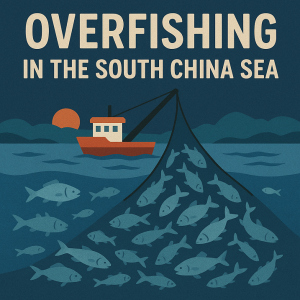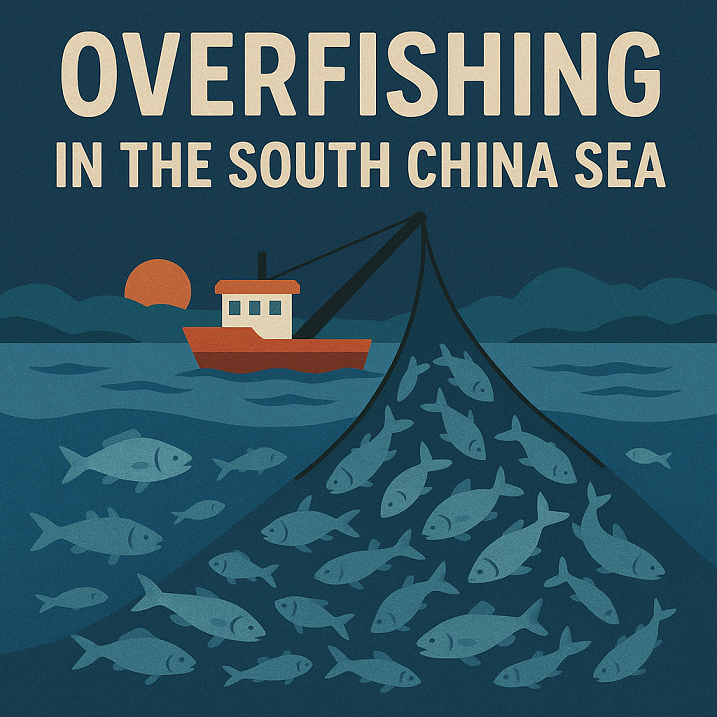Overfishing in the South China Sea threatens regional food security, disrupts marine ecosystems, and sparks geopolitical tensions. Explore the causes, consequences, and what can be done to protect one of the world’s most contested and vital seas.
Why Overfishing in the South China Sea Matters
 Stretching over 3.5 million square kilometers and bordered by China, Vietnam, the Philippines, Malaysia, Brunei, and Taiwan, the South China Sea is a marine treasure trove. It sustains the livelihoods of millions, supports regional food security, and hosts one of the world’s most biodiverse and economically valuable fisheries.
Stretching over 3.5 million square kilometers and bordered by China, Vietnam, the Philippines, Malaysia, Brunei, and Taiwan, the South China Sea is a marine treasure trove. It sustains the livelihoods of millions, supports regional food security, and hosts one of the world’s most biodiverse and economically valuable fisheries.
But this lifeline is rapidly depleting. Overfishing, compounded by illegal, unreported, and unregulated (IUU) fishing, is driving a collapse in fish stocks, according to UNCTAD and FAO data. The decline is not just an ecological concern; it has geopolitical, economic, and social ramifications that span borders and generations.
The International Maritime Organization (IMO), through the STCW Convention and FAO Port State Measures Agreement, emphasizes the need for sustainable practices and transboundary cooperation. But enforcement in disputed waters remains fragmented and often politicized.
A Marine Crisis in Numbers
The scale of the crisis is staggering:
- The South China Sea accounts for 12% of the global fish catch, but many key stocks have declined by more than 70% since the 1950s (World Bank, 2021).
- According to Global Fishing Watch, some areas of the sea experience fishing activity for over 300 days a year, pushing species beyond recovery.
- A 2022 study published in the Marine Policy Journal estimates that up to 90% of commercial fish stocks in the region are overexploited.
- The Philippines Bureau of Fisheries and Aquatic Resources (BFAR) reports that catch per unit effort (CPUE) in traditional fishing zones has dropped by more than 65% since 2000.
Causes of Overfishing in the South China Sea
Competition and Overcapacity
Fleets from surrounding countries vie for limited resources. Subsidies, especially fuel subsidies, incentivize large-scale industrial fleets to travel farther and fish longer. The Organisation for Economic Co-operation and Development (OECD) warns that these subsidies distort competition and fuel overcapacity.
IUU Fishing and Enforcement Gaps
IUU fishing is rampant in the South China Sea. Vessels often switch off AIS tracking, fish in protected areas, or falsify catches. Lloyd’s List Intelligence and MarineTraffic data show consistent AIS gaps in contested zones.
Coastal nations struggle to patrol vast maritime areas, and overlapping claims (especially involving the Nine-Dash Line) make enforcement politically sensitive. The 2016 Permanent Court of Arbitration ruling in favor of the Philippines clarified some legal boundaries, but enforcement remains a challenge.
Destructive Fishing Techniques
Blast fishing, cyanide fishing, and bottom trawling are still practiced in parts of the sea, especially by small-scale or unregulated fishers. These methods devastate marine habitats, destroy coral reefs, and hinder fish population recovery.
Climate Change and Habitat Loss
Warmer seas, ocean acidification, and coral bleaching further reduce spawning and nursery grounds. According to the Intergovernmental Panel on Climate Change (IPCC), sea surface temperatures in the region have risen by over 1.2°C in the past century, stressing already vulnerable ecosystems.
Consequences of the Stock Collapse
Economic Disruption
Millions of small-scale fishers from countries like the Philippines, Vietnam, and Indonesia rely on the South China Sea. As fish stocks dwindle, incomes drop and poverty rises. Coastal communities are forced to fish farther offshore, increasing operational costs and accident risks.
Geopolitical Tensions
Overfishing intertwines with sovereignty disputes. Coast guard encounters, vessel seizures, and diplomatic standoffs have increased. The militarization of fisheries protection, including the deployment of maritime militias, raises the stakes in an already tense region.
Food Security Threats
Fish is a staple protein source for over 500 million people in Southeast Asia. According to the International Food Policy Research Institute (IFPRI), declining fish availability has already led to higher prices and nutritional deficits in low-income populations.
Ecosystem Collapse
Overfishing disrupts food chains, reducing biodiversity. Apex predators disappear first, followed by cascading losses among smaller species. Coral reefs, already weakened by bleaching and pollution, struggle to regenerate without balanced fish populations.
Case Study: Scarborough Shoal
Located about 220 km west of Luzon, Scarborough Shoal is claimed by both China and the Philippines. It’s a traditional fishing ground with rich biodiversity. However, since 2012, Filipino fishers have faced restricted access due to Chinese patrols.
A 2023 report by Greenpeace Southeast Asia documented coral damage, declining fish stocks, and a rise in illegal dredging around the shoal. Interviews with Zambales-based fishing communities highlighted a loss of income by up to 80%, forcing some to abandon fishing altogether.
Current Measures and Regional Cooperation Efforts
ASEAN Initiatives
The ASEAN Working Group on Fisheries and the Southeast Asian Fisheries Development Center (SEAFDEC) promote sustainable practices. However, binding agreements remain limited due to political sensitivities and varying enforcement capacities.
Technology and Monitoring Tools
Tools like Global Fishing Watch, AIS tracking, and remote sensing have improved transparency. Initiatives supported by Inmarsat and MarineTraffic help monitor vessel behavior, though spoofing and signal blackouts remain challenges.
The Role of Marine Protected Areas (MPAs)
Establishing MPAs has shown promise. In Vietnam’s Con Dao Archipelago, MPAs supported by the UNDP have led to a 30% increase in fish biomass within a decade. Yet, only about 1.34% of the South China Sea is currently protected.
Bilateral Agreements
The Philippines and Vietnam have explored joint fishing agreements and resource-sharing protocols. However, such bilateral pacts remain rare and often fragile under political pressure.
Future Outlook: Charting a Sustainable Course
Regional Fisheries Management Organization (RFMO)
Experts from WMU and ICS have advocated for a dedicated RFMO for the South China Sea, modeled on frameworks like the Northwest Atlantic Fisheries Organization (NAFO). This could standardize stock assessments, allocate quotas, and enforce conservation zones.
Sustainable Aquaculture as an Alternative
Countries like Indonesia and Vietnam are investing in aquaculture to reduce pressure on wild stocks. But without proper regulation, fish farms can lead to pollution, antibiotic overuse, and habitat destruction.
Education and Community-Led Conservation
Training fishers in sustainable practices, offering alternative livelihoods, and involving local communities in conservation (as seen in parts of the Philippines and Malaysia) have yielded measurable results.
Blue Economy Integration
Sustainable fisheries should form a pillar of the Blue Economy approach, combining economic growth with environmental responsibility. The World Bank Blue Economy Framework offers a strategic roadmap, aligning marine resource use with long-term resilience.
Frequently Asked Questions (FAQ)
Why is the South China Sea important for global fisheries?
It provides 12% of the world’s fish catch and supports the livelihoods of millions in Asia.
What are the main causes of overfishing in this region?
Overcapacity, IUU fishing, destructive practices, and poor enforcement due to geopolitical disputes.
How does overfishing affect regional stability?
It heightens competition over resources, leading to maritime conflicts, economic hardship, and migration pressures.
Are there any sustainable solutions being implemented?
Yes, including MPAs, bilateral agreements, aquaculture, and tracking technologies. But uptake varies by country.
What role can international bodies play?
IMO, FAO, UN, and regional RFMOs can help set guidelines, fund conservation, and foster cooperation beyond political lines.
How can local communities contribute to solutions?
Through education, reporting IUU fishing, engaging in community-led conservation, and shifting to sustainable livelihoods.
Conclusion
Overfishing in the South China Sea is more than a maritime problem—it’s a regional emergency with global implications. From food security to geopolitical stability, the stakes are high. But pathways for recovery exist. With better cooperation, stronger enforcement, sustainable alternatives, and community engagement, the South China Sea can still serve as a model of resilience and shared stewardship.
Time is short, but the tide can still turn.
References
- FAO. (2022). The State of World Fisheries and Aquaculture. https://www.fao.org/3/cc0461en/cc0461en.pdf
- UNCTAD. (2021). Sustainable fisheries and trade. https://unctad.org/system/files/official-document/ditcted2021d3_en.pdf
- World Bank. (2021). Blue Economy for the South China Sea. https://www.worldbank.org/en/news/feature/2021/06/08/blue-economy-south-china-sea
- Global Fishing Watch. https://globalfishingwatch.org
- Marine Policy Journal (2022). Fish stock assessments in the South China Sea. Elsevier. https://www.journals.elsevier.com/marine-policy
- Greenpeace Southeast Asia (2023). Scarborough Shoal Investigations. https://www.greenpeace.org/southeastasia/publication/Scarborough-shoal-report
- IPCC Sixth Assessment Report. https://www.ipcc.ch/report/ar6/syr/
- WMU Journal of Maritime Affairs. https://link.springer.com/journal/13437
- ICS Shipping Publications. https://www.ics-shipping.org/publications/
- Inmarsat Maritime Safety & Security. https://www.inmarsat.com/en/solutions-services/maritime.html

